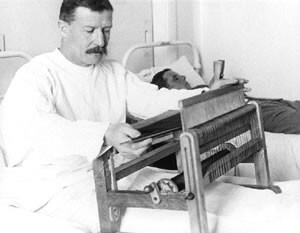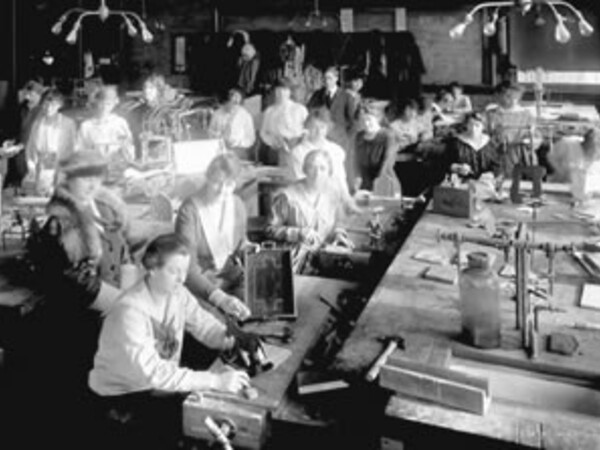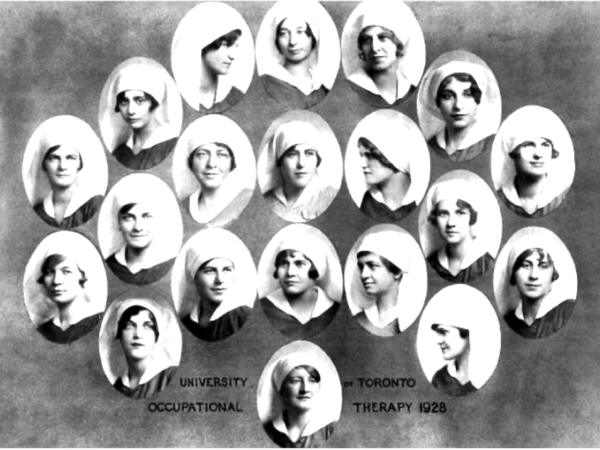Breadcrumbs
Program History
Canadian Occupational Therapy Education Begins at U of T

There are actually two beginnings for occupational therapy at the University of Toronto: one in 1918 and one in 1926. Our first program was designed for ward aides to work with the injured soldiers of World War I. Ward aides were employed by the Military Hospitals Commission of Canada to provide the soldiers with occupations, generally in the form of crafts, to “rehabilitate” their spirit during long periods of convalescence. From bedside and ward occupations, the soldiers progressed to off-ward occupations and to curative workshops. At later stages, soldiers who were unable to return to their former jobs were given occupations related to their vocational retraining. Similar occupation-based work had been carried out for decades in mental institutions and also in tuberculosis sanatoriums so there was already some basis on which to build this program. As each year of the war went by and the numbers of injured soldiers continued to increase, the Military Hospitals Commission realised it needed more women to work as ward aides. The University of Toronto (U of T) volunteered to help meet this need and started short courses to train ward aides in 1918. The courses were run by the Faculty of Applied Science and Engineering and held in the basement of the Mining Building. From 6-week courses, they developed into 6-month courses and when the last course finished in the fall of 1919, some 300 women had been trained as ward aides and were working across the country.

The ward aides continue to work with veterans after the war ended. They also continued to work in mental institutions and tuberculosis sanatoriums and by 1920 they had begun working in general hospitals as well. They soon realised that there would be a continuing need for the service they were providing. The ward aides who were based in Ontario organized themselves into the Ontario Society for Occupational Therapy (OSOT) and received their provincial charter in 1921. In addition to promoting occupational therapy as treatment, OSOT began planning for a proper training course to be housed at the University of Toronto. With influential people on their Advisory Board (including Dr Primrose, then Dean of the Faculty of Medicine, and Sir Robert Falconer, the President of the University), they were able to establish a new program in 1926.

This “second beginning” for OT at U of T was a two-year diploma course. It was run by the Department of Extension, a structural entity that oversaw programs with somewhat uncertain futures. The course was advertised in the Commencement Bulletin the preceding June as a “new course for young ladies who are anxious to be of service in the healing of the sick and maimed and convalescent.” In 1946, the course was extended to 3 years, and in 1950, occupational therapy and physical therapy were combined into one program and brought into the Faculty of Medicine as part of the Division of Rehabilitation Medicine. The program was known as “P&OT” and its graduates were affectionately known as “POTS”. Although combining the programs was not considered desirable by many – there was at last a permanent home for the program in the Faculty of Medicine. Some 20 years later, the programs separated again to become individual degree programs, with the first students graduating with a BSc (OT) degree in 1974. In 2000, occupational therapy became a graduate program offering an MScOT degree.
In recommending the program to the University in 1926, the letter to the University Senate noted that there was a desire “to make the University of Toronto Extension Course the headquarters for the Dominion of Canada, so that pupils will not be of Provincial origin alone, but will come from all parts of the Dominion.” Indeed this intention was realised as the U of T program remained the only university program in Canada until 1950, and the only one in Ontario until 1967. In fact the program at U of T was one of just five schools of occupational therapy in all of North America to be recognized in 1935 by the American Medical Association, the academic accrediting body of the time. The schools were in Boston, St Louis, Philadelphia, Milwaukee, and Toronto. Class size at U of T varied tremendously over the years and ranged from as few as 13 during the early years of the depression, to 120 in the post-war class of 1947.
Because it was the only educational program in Canada until 1950, OT at U of T provided most of the occupational therapists for the country. As a result, our grads held most of the senior clinical positions and greatly influenced the development of the profession. When new educational programs began to develop at other Canadian universities, the directors were usually selected from among U of T grads and they too greatly influenced the development of the profession. Grads from OT at U of T continue those traditions today, making their influence felt across the nation, and around the world.
Judith Friedland. PhD, OT Reg (Ont), FCAOT
Professor Emerita
July 17, 2006
